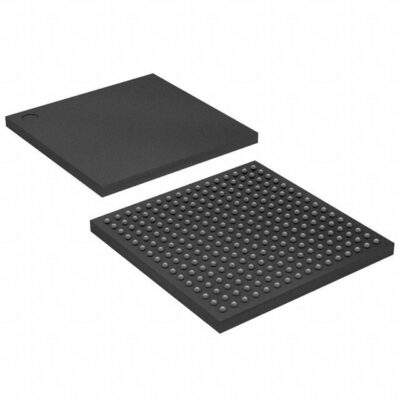EP4CE6F17C8N
Part Number: EP4CE6F17C8N
Manufacturer: Intel
Description: IC FPGA 179 I/O 256FBGA
Shipped from: Shenzhen/HK Warehouse
Stock Available: Check with us
ICRFQ.com - Electronic Components Distributor in China Since 2003

Part Number: EP4CE6F17C8N
Manufacturer: Intel
Description: IC FPGA 179 I/O 256FBGA
Shipped from: Shenzhen/HK Warehouse
Stock Available: Check with us
| Datasheet | |
|---|---|
| Category | Integrated Circuits (ICs) |
| Family | Embedded – FPGAs (Field Programmable Gate Array) |
| Manufacturer | Altera |
| Series | Cyclone? IV E |
| Part Status | Active |
| Number of LABs/CLBs | 392 |
| Number of Logic Elements/Cells | 6272 |
| Total RAM Bits | 276480 |
| Number of I/O | 179 |
| Number of Gates | – |
| Voltage – Supply | 1.15 V ~ 1.25 V |
| Mounting Type | Surface Mount |
| Operating Temperature | 0°C ~ 85°C (TJ) |
| Package / Case | 256-LBGA |
| Supplier Device Package | 256-FBGA (17×17) |
FPGAs (Field Programmable Gate Arrays) are critical components in modern electronics, providing unparalleled flexibility in hardware design. This page describes the EP4CE6F17C8N FPGA, which is part of the Cyclone IV E series and is well-known for its versatility and performance. We will investigate the significance of FPGAs and the architecture of the EP4CE6F17C8N, illustrating their critical role in a variety of sectors. Whether you’re a seasoned engineer or a beginner, this tutorial will help you navigate the world of FPGAs efficiently.
The EP4CE6F17C8N FPGA, which is part of the Cyclone IV family, has a versatile architecture that can support a wide range of applications. This section gives a summary of the main architectural components:
With its mix of logic parts, memory, and configurability, the EP4CE6F17C8N FPGA finds applications in a wide range of real-world scenarios across industries. Here are some examples of common applications and case studies:
The EP4CE6F17C8N FPGA can be utilized in automotive applications for real-time control and data processing from sensors like as LiDAR and radar to enable advanced driver assistance systems (ADAS) and autonomous driving.
The FPGA can be used in a manufacturing facility for high-speed data acquisition and control in robots and assembly line systems. It can process sensor data and control actuators, allowing it to optimize manufacturing operations.
The FPGA can be used as a versatile platform for network packet processing in telecommunications, providing efficient data routing and network management in switches and routers.
The FPGA can improve image processing capabilities in medical imaging equipment, such as ultrasound scanners, allowing for real-time image enhancement and analysis for accurate diagnostics.
The FPGA in radar systems for military aircraft can analyze incoming radar data with great precision, detecting and monitoring several targets at the same time to improve situational awareness.
The FPGA in oscilloscopes can offer enhanced triggering and signal processing capabilities, allowing engineers to accurately collect and analyze complicated electronic signals.
The FPGA can be utilized in professional audio equipment for real-time audio signal processing, providing features such as noise reduction and equalization in high-end audio mixers.
The FPGA can aid real-time data gathering and processing in scientific investigations, allowing researchers to collect and evaluate data with minimal delay, as shown in high-energy physics studies.
The FPGA can provide hardware acceleration for data preprocessing activities in IoT devices such as smart sensors and edge computing platforms, decreasing the burden on the main CPU and conserving power.
The FPGA can be used in high-definition televisions for video upscaling, which improves the quality of lower-resolution content for a better viewing experience.
These applications demonstrate the EP4CE6F17C8N FPGA’s versatility in allowing real-time processing, data management, and control operations across a wide range of sectors. Because of its adaptability and capacity to modify its performance to specific needs, it is a valuable component in modern electronic systems.
Finally, the EP4CE6F17C8N FPGA exemplifies the dynamism and versatility of modern electronics. Its adaptable architecture, extensive I/O capabilities, and precise clock management provide a blank canvas for invention across a wide range of sectors. As we navigate an ever-changing technological world, this FPGA continues to be a strong tool, allowing engineers and developers to create the future of digital design. The EP4CE6F17C8N FPGA is significant not only for its current applications, but also for the limitless possibilities it opens up for anyone willing to investigate and push the frontiers of what is possible in the realm of programmable logic. The EP4CE6F17C8N FPGA is a reliable ally on this voyage of discovery, eager to turn ideas into reality.
Contact ICRFQ, a reliable Chinese electronic components supplier, today to learn more about this exceptional product’s capabilities and to place your order. Don’t miss out on the EP4CE6F17C8N FPGA’s opportunity to boost your electronic creations.
WhatsApp us